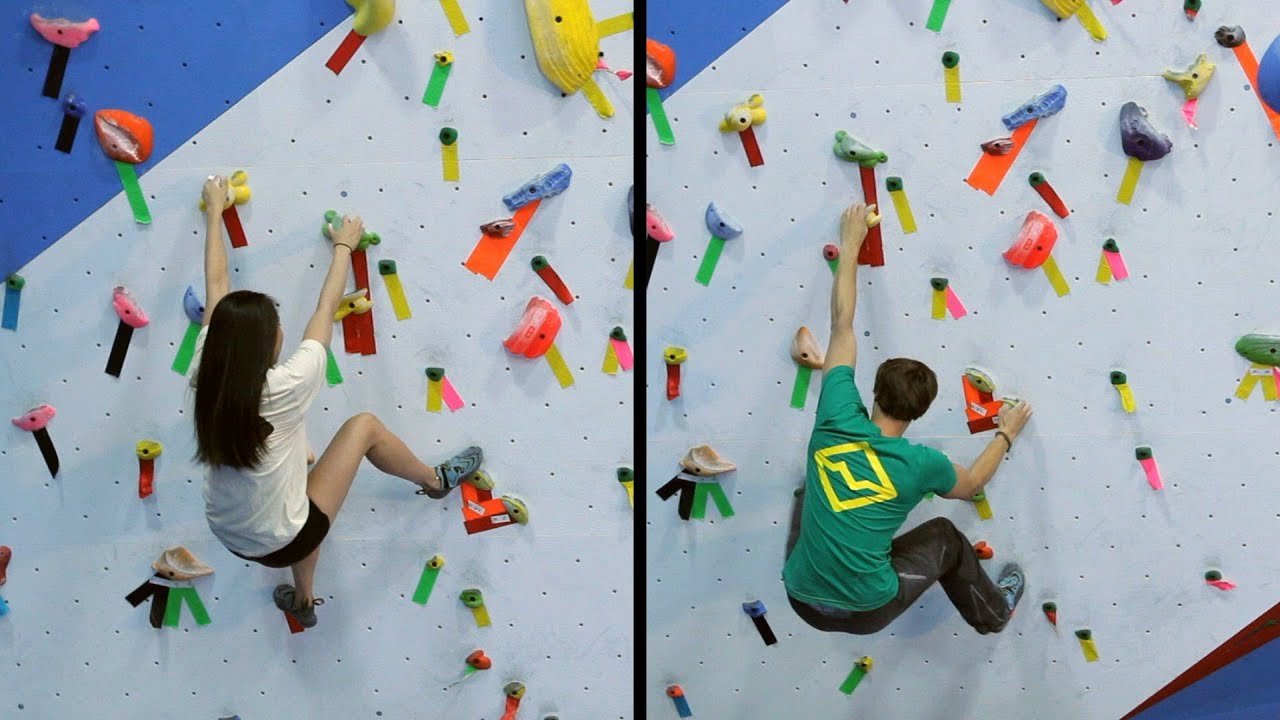Solving Problems Based on Body Type | Rock Climbing
Full Playlist: https://www.youtube.com/playlist?list=PLLALQuK1NDrjugIQA3Te01g3ksXghWCMR
–
–
Rockin’ Rock Climbing Commodities
Momentum Climbing Harness: http://amzn.to/1iN4Caq
La Sportiva Tarantulace Men’s Climbing Shoe: http://amzn.to/1FL2Qvz
La Sportiva Tarantulace Women’s Climbing Shoe: http://amzn.to/1UTo5SH
Half Dome Climbing Helmet: http://amzn.to/1QfLxZ8
Chalk Bag with Belt and Zippered Pocket: http://amzn.to/1OtW84a
REVERSO 4 Belay Device: http://amzn.to/1F170Vi
Watch more How to Rock Climb videos: http://www.howcast.com/videos/512707-Solving-Problems-Based-on-Body-Type-Rock-Climbing
So, a big part of trying to figure out how to do a particular climb isn’t always necessarily how to do each move, but the sequence that you’re doing it and how to climb a way that’s right and appropriate for your body type and your climbing style. There’s lots of folks that are tall climbers, short climbers, male climbers, female climbers.
Everybody’s body type is different, and your climbing style is going to reflect that. So, watching Tiffany and Gaz both climb the same boulder problem, you’ll see some evident differences in the way they approach that climb.
For example, when you’re a shorter climber, and there’s a hold that you can’t reach, the answer isn’t always ‘you’re too short, you just can’t do it’ or ‘you have to get stronger’. Sometimes, it’s the simple position. So, for shorter climbers, you’re going to find the need to be constantly using very high feet. That may be difficult for a taller climber to get that scrunched up. But for shorter folks, being able to kind of get your body kind of scrunched and then expand from that position can allow you to cover a whole lot of ground without having to be any taller or necessarily any stronger.
Also, for a taller climber, it’s OK to be using your reach as a big part of the advantage. If you can keep your feet low and be able to grab some other holds and advance your position upwards without having to jump and do that move dynamically, that could be a big bonus. Also, it’s going to be difficult for the tall climber, like I said, to be in that scrunched position. So, maybe avoiding that type of move by using your reach and your extension rather than getting all scrunched up could be an easy way to figure out how to get around some of those difficult moves that you’re encountering.
So, you’ll notice as well, Gaz, using some more dynamic moves, maybe skipping some holds, just really being able to power his way through these moves. Tiffany may be having a more technical, delicate approach to the climb, perhaps making more moves, adding some additional feet, things like that, so they’re both able to climb the same boulder problem using the same holds and likely the same feet. It would be about the same difficulty if they figure out how to climb it in a way that fits their body type.
Sometimes, there will be a climb that might be really difficult for someone and really easy for another person simply because you’re a different type of climber. Maybe you are taller or you are shorter. It doesn’t mean it’s going to be impossible. It’s just going to be different. So, feel free to explore the different types of moves when you’re climbing. Don’t hesitate to get some high feet when you’re a shorter climber, and don’t hesitate to use the length as an advantage if you’re a taller climber.
If you’re powerful, feel free to jump, release those feet from the wall, be very dynamic. As a technical climber, maybe you can’t do a ton of pull-ups. There’s lots of ways you can use balance to your advantage. Very nice footwork, always moving nice and slowly with precision, and kind of tick tack your way up a route that someone might just want to jump and skip. So, a couple of techniques and different ways you can problem-solve while you’re climbing.



![[ID: nRNa_HkgYFQ] Youtube Automatic](https://bizimtube.com/wp-content/uploads/2021/03/id-nrnahkgyfq-youtube-automatic-236x133.jpg)
![[ID: nKvpMq-k4VE] Youtube Automatic](https://bizimtube.com/wp-content/uploads/2021/03/id-nkvpmq-k4ve-youtube-automatic-236x133.jpg)
![[ID: yhITUFbi7H8] Youtube Automatic](https://bizimtube.com/wp-content/uploads/2021/03/id-yhitufbi7h8-youtube-automatic-236x133.jpg)
![[ID: 1G3UK4EgsIM] Youtube Automatic](https://bizimtube.com/wp-content/uploads/2021/03/id-1g3uk4egsim-youtube-automatic-236x133.jpg)
![[ID: _zHdzEzAt9o] Youtube Automatic](https://bizimtube.com/wp-content/uploads/2021/03/id-zhdzezat9o-youtube-automatic-236x133.jpg)
![[ID: gqgRajnKkBI] Youtube Automatic](https://bizimtube.com/wp-content/uploads/2021/03/id-gqgrajnkkbi-youtube-automatic-236x133.jpg)
![[ID: 5-3fSrQTBxI] Youtube Automatic](https://bizimtube.com/wp-content/uploads/2021/03/id-5-3fsrqtbxi-youtube-automatic-236x133.jpg)
![[ID: ouCtbSdrkWc] Youtube Automatic](https://bizimtube.com/wp-content/uploads/2021/03/id-ouctbsdrkwc-youtube-automatic-236x133.jpg)
![[ID: MgYLCr1GLO8] Youtube Automatic](https://bizimtube.com/wp-content/uploads/2021/03/id-mgylcr1glo8-youtube-automatic-236x133.jpg)
![[ID: vVCcQJpk2H4] Youtube Automatic](https://bizimtube.com/wp-content/uploads/2021/03/id-vvccqjpk2h4-youtube-automatic-236x133.jpg)
![[ID: hCMKysXAbco] Youtube Automatic](https://bizimtube.com/wp-content/uploads/2021/03/id-hcmkysxabco-youtube-automatic-236x133.jpg)
![[ID: fM9J7p32XCA] Youtube Automatic](https://bizimtube.com/wp-content/uploads/2021/03/id-fm9j7p32xca-youtube-automatic-236x133.jpg)